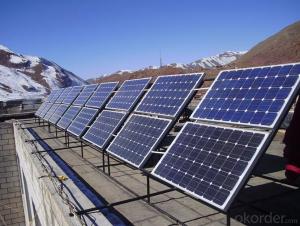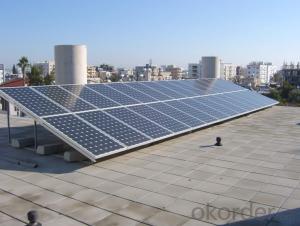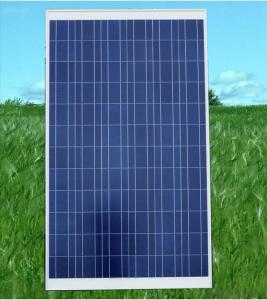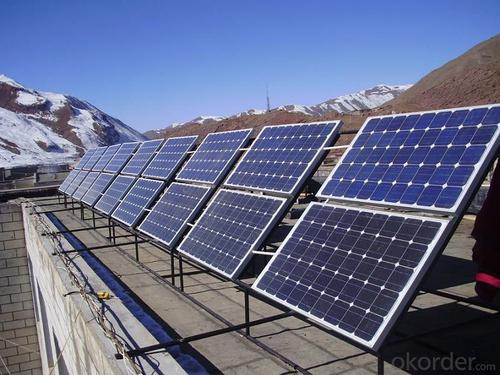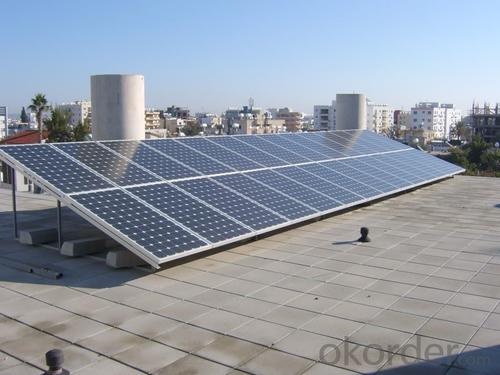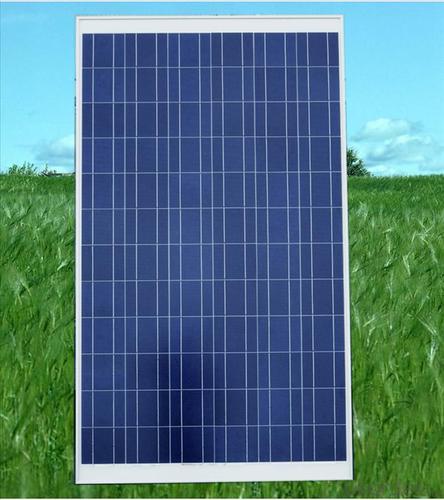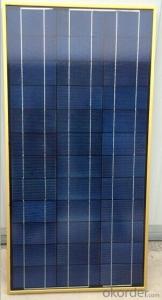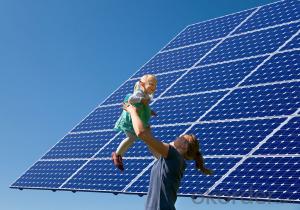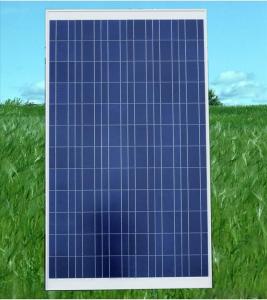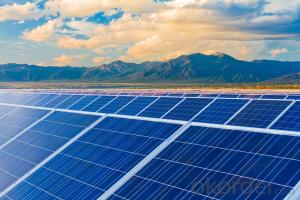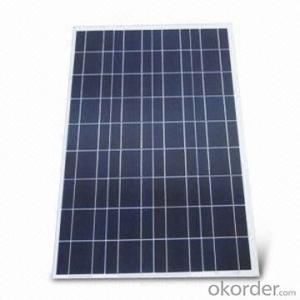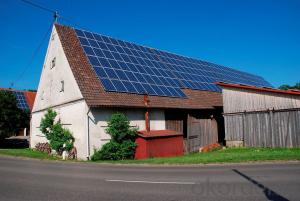600W Polycrystalline Silicon Solar Panel
- Loading Port:
- Nanjing
- Payment Terms:
- TT OR LC
- Min Order Qty:
- 200000 watt
- Supply Capability:
- 20000000 watt/month
OKorder Service Pledge
OKorder Financial Service
You Might Also Like
INTRODUCTION
This installation Manual contains essential information for the electrical and mechanical installation that your must know before installing CUSTOMER PV modules. This also contains safety information you need to be familiar with .All the information described in this manual are the intellectual property of CNBM and based on the technologies and experiences that have been acquired and accumulated in the long history of CUSTOMER. This document does not constitute a warranty, expressed or implied.
CUSTOMER does not assume responsibility and expressly disclaims liability for loss, damage, or expense arising out of in anyway connected with installation, operation, use or maintenance of the PV modules. No responsibility is assumed by CUSTOMER for any infringement of patents or other rights of third parties that may result from use of PV module.
CUSTOMER reserves the right to make changes to the product, specifications or installation manual without prior notice.
WORK PRINCIPLE
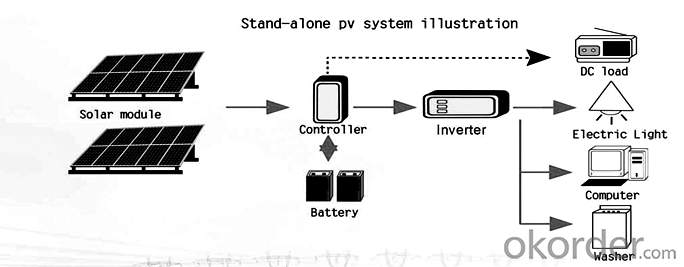
COMPONENTS
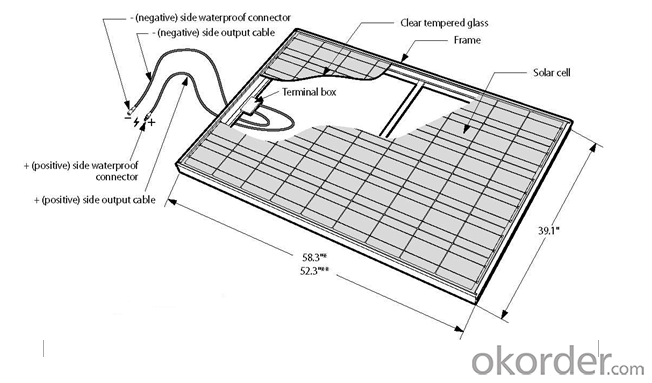
WIRING
To ensure proper system operation to maintain your warranty, observe the correct cable connection polarity(Figures 1&2) when connecting the modules to a battery or to other modules. If not connected correctly, the bypass diode could be destroyed.
PV modules can be wired in series to increase voltage. Connect wires from the positive terminal of one module to the negative of the next module. Figure shows modules connected in series .
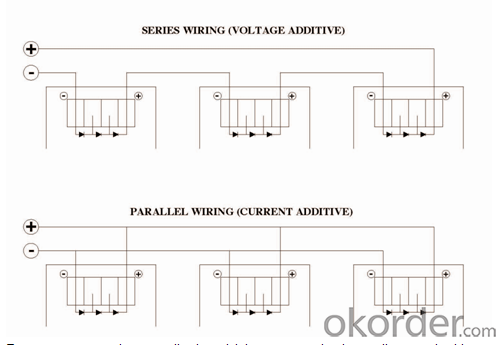
DATA SHEET
Maximum Power | 240W |
Efficiency | 0.148 |
Backsheet | White |
Frame Colar | Silver |
Manufacture Site | China |
Frame | Anodized Aluminum Alloy |
Weight | 19 kg |
FAQ:
1. How long will my inquiry get response?
Your inquiry related to our products or prices will be replied within 24 hours.
2. Can I get professional service and suggestion?
Well-trained and experienced staffs to answer all your questions in fluent English.
3. Do you accept OEM or customized design?
OEM & ODM, any your customized lightings we can help you to design and put into product.
4. What if I need specific design?
Distributorship are offered for your unique design and some our current models.
- Q: How will i construct solar panel?
- The first step to planning your system is to evaluate rebate options and obtain permits. Deciding the size of your system is the next step. With a grid-tied system, size is less critical, because the grid supplies power when your PV system falls short. Systems as small as a couple hundred watts are practical, but you can also install panels that will produce enough electricity for all your needs.
- Q: I'm thinking of these solar panels that people have on their rooftops in domestic properties. I suppose I mean after how long do you break even with respect to just carrying on without them and getting you electricity from the utilities companies? Or answer in any way you think is pertinent. The more info the better.
- It's generally stated that it takes 0 years for them to pay for themselves. But the concept of paying for themselves is a primitive concept used by those who do not understand finances. You're still losing money when it pays for itself. A more appropriate analysis would be the Internal Rate of Return calculations, Excel makes this calculation easy. Overall,?solar power?is expensive power and works out about 38 cents per kwh ( proper economic estimates typically place it between 23 cents to 45 cents per kwh ). Some idiot here will insist solar doesn't cost that much per kwh, it does unless you're uneducated in finance. Note, it's also not clear if the energy produced by?solar panels?exceeds the energy required for their manufacture, delivery and installation. It takes a lot of energy to melt silicon and the costs triple if you try to recycle the toxic wastes which is why the panels are made where it's still possible to dispose of the toxic wastes. They could very well be causing more environmental damage then they save. With the Europeans what happens is the feed in tariffs makes the solar panels worthwhile. They still don't really pay for themselves but they allow you to take some of the tax money from your neighbors, a bit of an ethical dilemma really but ethics never stopped Europeans.
- Q: what direction should solar panels face to get the best exposure of the sun.
- Not compass south, but solar south. It's easy to find. Google Find Solar south and you can get directions. Even better are trackers, that will let your panels track the sun all day.
- Q: Can solar panels be installed in rural areas?
- Yes, solar panels can be installed in rural areas. In fact, rural areas often have more space and sunlight, making them ideal for solar energy generation. Installing solar panels in rural areas can provide access to clean and renewable energy, reduce reliance on fossil fuels, and bring electricity to remote communities that are not connected to the grid.
- Q: All I know is they check for amps watts voltage and everything... they dont have to be used for solar panels but um they have like alittle spinny thing in the middle of them. you spin it around to what you wanna test such as the amps watts voltage and stuff.... idk what their called but im looking to buy one to test my solar panels when they come in
- They're called...Electric Testers, or Voltage Testers, or whatnot, they don't really have a special name in my experience. Just go to your local hardware store and buy one.
- Q: I know that the Solar panels store the power from the sun in the daytime, where does that stored energy go from there? Is it stored in the batteries? And how would you keep the batteries topped up if you had no Electric? by a generator? interested in solar panels for abroad, but need more info.
- Solar panels do not store power. Solar panels convert sunlight into electricity. To store power you need batteries. The usual type of batteries used are lead-acid deep discharge( similar to car batteries). The batteries are charged up during the time the sun is out. However, as a backup you could also have a generator handy to provide power for times when the sun did not shine enough to keep the batteries charged up.
- Q: am having a 75 watts siemens solar panel and is giving me 2.89volts during bright light, i wanted to know can this be used to charge 00Am/hr battery?
- Many of the panels used on homes are designed to produce 2 volts DC. 0 of them wired in a series would produce 20 volts DC. An inverter is used to change the DC voltage to AC. The other aspect of electricity is amperage. With electrical units wired in series the voltage is added. When they are wired in parallel the amperage is added. The Volts x Amps produced will give you the wattage. A wise homeowner will examine their electric bills or the equipment used to determine their demand. They will consult tables that let them know how much sunlight their area receives each year as this will alter the rated performance of the panels. Then they will try and determine how much of the demand they want to fill. 80% may be economical. Then they also want to determine what they will do with excess electricity that may be produced during the summer months of intense sun and how they will supply the shortfall of low sun winter months. From all this they will determine the number of solar panels they need to purchase.
- Q: Are the solar panels on the roof just a gimik to get all the tree huggers to buy it, or are they actually a good, efficent design?
- The solar panels run the fan to remove hot air from the car. They do about the same amount of cooling that cracking the windows and using a heatshield over the windshield--that is they keep the interior of the car about the same as the exterior without draining the 2V battery. One problem I have with the solar panels is that they come with a moonroof. The other problem I have with them is that to get them you have to give up the additional safety features because Toyota won't put both the high tech safety features and the solar panels on the same car. So is it a good design? Well, nothing with a sun/moonroof is a good design IMHO, but that's the power of advertising for you. In that it runs a fan without draining the 2V battery, yes that part's good. Having to give up the high tech safety features to get it makes it a non-starter for me (and I live where it gets plenty hot so I could really use the fan).
- Q: Looking to install solar panels in my house.
- Wholesale prices for BP solar panels range between $335 for the 40 watts panel to $835 for the 70 watts panel. Here's a brief listing of wholesale prices for BP solar models: - BP340J solar panel (40 watts) @ $335 - BP350J solar panel (50 watts) @ $37 - BP375J solar panel (80 watts) @ $504 Right now I'm getting a series of 50 watt (7.5 volts) panels installed in my house. It's a start to reduce dependence on electricity bills and try get some tax rebates as well.
- Q: Is it good? ( solar energy)
- It depends mainly on where you live - both politically and geographically. It's very worthwhile if you live in the Southern hemisphere and your house faces north. The same holds true if you live in the Northern hemisphere in a south-facing dwelling. If your government gives a generous rebate towards your purchase of the panels (as the Australian one does) then ,yes, it is worthwhile as you can make your money back in only a few years. Of course if your motivation is more an ecologic than economic one then go ahead and do it.
Send your message to us
600W Polycrystalline Silicon Solar Panel
- Loading Port:
- Nanjing
- Payment Terms:
- TT OR LC
- Min Order Qty:
- 200000 watt
- Supply Capability:
- 20000000 watt/month
OKorder Service Pledge
OKorder Financial Service
Similar products
Hot products
Hot Searches
Related keywords
